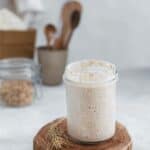
Simple Sourdough Starter
Learn how to make and feed your very own sourdough starter, letting you create the most tantalizing breads, pizza dough, doughnuts, pancakes, and even homemade pretzels. All you need are two ingredients, a glass jar, and you’re well on your way to unlocking the magic of a sourdough starter.
Servings 12 tablespoons, ¾ cups (180g)
Calories 94kcal
Equipment
- 1 Sterile Glass Jar
Ingredients
- ½ cup (60 g) whole wheat flour
- 1¼ cups (300 ml) warm water
- 2 cups (240 g) all purpose flour
Instructions
Day 1 - Make the Starter
- Add ½ cup (60g)whole wheat flour with ¼ cup (60 ml g) warm water 75℉ (24℃) to a sterile 1 gallon (3.75 liters) glass jar, mixing with a stainless steel or wooden fork until smooth. Lightly cover the jar, letting it rest in a warm spot in the kitchen at approximately℉ (24℃) for 24 hours.
Day 2 - After 24 Hours
- You’ll notice tiny bubbles appearing on top of your starter, which means you’re off to a good start. The bubbles mean it's starting to ferment. Nothing else is needed for the next 24 hours; just leave it lightly covered in the same warm spot.
Day 3 - It's Feeding Time
- To get started, remove and discard half the contents in the starter, so you’re left with 4 tablespoons (60 g). At this point, the texture of the starter will be very elastic or stretchy. Use a stainless steel or wooden fork to mix in ½ cup (60 g) all-purpose flour with ¼ cup (60 ml) warm water, mixing until smooth. Lightly cover the glass jar, leaving it in the same warm spot in your kitchen for another 24 hours.
Day 4, 5 & 6 - Repeat
- Repeat the feeding steps of discarding half and mixing in ½ cup (60 g) all-purpose flour with ¼ cup (60 ml) warm water every 24 hours of these three days. The goal is to have your starter double in size; this is how you know it's ready to use.
Day 7 - Time to get started
- By this day, the starter should have doubled in size, with both large and tiny bubbles throughout the whole starter. You're now ready to get started baking some beautiful bread. Note: If the starter has not doubled in size by day seven, repeat the feeding steps, leaving it for another day or two if needed, until it has doubled in size.
Notes
Storing and keeping your starter alive: If you do a lot of baking, it can be left at room temperature and fed daily. If you're only planning on baking once in a while, it can be stored in the fridge and fed weekly.
Using your starter:
- From the fridge: If your starter is stored in the fridge, pull it out, feed the starter the night before leaving it at room temperature overnight, and you’re ready to bake.
- Room temperature: If your starter is already at room temperature, simply continue your feeding schedule.
- Plan ahead! The sourdough starter needs 7 days to be ready to use.
- Use a piece of tape or an erasable marker to make a note of where your starter began to easily tell when it has doubled in size.
- It's best practice to use an instant-read kitchen thermometer in order to check the room and water temperatures when making a sourdough starter.
Nutrition
Calories: 94kcal | Carbohydrates: 20g | Protein: 3g | Fat: 0.3g | Saturated Fat: 0.1g | Polyunsaturated Fat: 0.1g | Monounsaturated Fat: 0.03g | Sodium: 2mg | Potassium: 41mg | Fiber: 1g | Sugar: 0.1g | Vitamin A: 0.5IU | Calcium: 6mg | Iron: 1mg